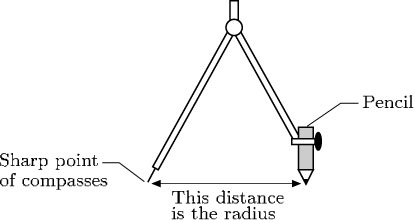2.4 Drawing circles
Drawing circles freehand often produces very uncircle-like shapes! If you need a reasonable circle, you could draw round a circular object, but if you need to draw an accurate circle with a particular radius, you will need a pair of compasses and a ruler. Using the ruler, set the distance between the point of the compasses and the tip of the pencil at the desired radius; place the point on the paper at the position where you want the centre of the circle to be and carefully rotate the compasses on the point so that the pencil marks out the required circle.

To draw a large circle, perhaps to create a circular flower bed, a similar set-up is needed. The essentials are a fixed central point (possibly a stake) and a means of ensuring a constant radius (possibly a string). To draw a circle on a computer or calculator screen, you may also need to fix the centre (maybe using coordinates) and the radius.
It is often necessary to label diagrams of geometric figures, such as circles or triangles, in order to make it easier to refer to specific parts of the figure. Usually points are labelled as A, B, C, … and lines as AB, BC, …, or a, b, c, … and using combinations of the letters, such as ‘triangle ABC’ (‘Triangle ABC’ is often written as ‘ΔABC’.). It is rather laborious to read, but unfortunately is unavoidable.
Note that, as in the case of words like ‘radius’ and ‘circumference’, AB may be used to mean the line from A to B or the length of the line itself.
